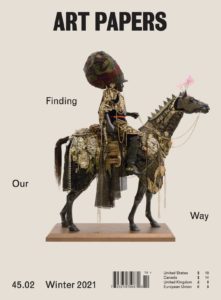Finding Our Way
Share:
The stairway which leads to my room
leads to an observatory
I own two telescopes
to observe stars and black holes
and take mechanized stairs
which advance with no advance
—Etel Adnan, from “The Manifestations of the Voyage”
INTERSECTING THINGS
RIPPED ASUNDER
STICKS ENOUGH TO BRIDGE
THE ENDS OF THE EARTH
—Lawrence Weiner, from BARD ENTER
I want to begin this letter by marking two recent and momentous losses—the passings of artist and poet Etel Adnan and of conceptual artist Lawrence Weiner. Both leave behind immeasurable influences on the realms of visual art and letters. Both also bore influence on the conceptualization of this ART PAPERS issue’s theme: Finding Our Way.
This issue explores forms of individual and collective wayfinding. It traverses artist practices that embrace being lost and that create symbolic cartographies to map histories of self and community. Wayfinding implies a forward-looking perspective, but finding our way is also about finding ourselves, and our place—not only on the map, but within history, in the present moment, to imagine possible futures.
The challenges of finding our way rarely conclude upon arrival, where one must then find a way to be, and a way forward, beyond that destination. In “Against Confinement—On Mohamed Bourouissa’s Frames of Relation,” Stephanie Bailey traces the lines of Bourouissa’s practice, which draws entangled webs of interrelationships between histories of place, transplanted languages, and migrated cultural influences to create “rehumanizing representations.” In this expansive appraisal of the artist’s work, Bailey makes a case for the emancipatory power of images.
In “A World Before the World We Know,” Cosmo Whyte speaks with Hew Locke about how Locke’s work delves into deep histories of migration and colonialism, and in his newest works, offers a vision of imagined heroes carrying hybrid histories into an unknowable future.
In “Floating Worlds Apart,” Lydia Horne interviews Doireann O’Malley about their work in hyperspace simulation, about VR environments as an opportunity to explore space in a genderless body, and about collapsing the distinction between actual and symbolic experiences.
Measured and Reformed Constitutions, Krista Clark’s artist project for this issue, spotlights her practice of creating delicate works on paper that allude to the aesthetics of building, construction, and architecture. These explorations hover in a space of imminence, of indeterminacy, infused with notions of home, shelter, and security, as well as of instability, displacement, and flux.
In their collaborative text, “We Meet in a Patchwork: Landscapes and Elsewheres,” DJ Hellerman and Makshya Tolbert take a pilgrimage of sorts to the Virginia Museum of Fine Arts for The Dirty South: Contemporary Art, Material Culture, and the Sonic Impulse, and conjure an ekphrastic call-and-response to selected works from the exhibition. Tolbert and Hellerman also explore the affects and resonances within their budding friendship, framed by their recent relocation to the Southeastern US.
In this issue’s glossary entry, Dominique White reinvents the term shipwreck—transforming its meaning from a literal destruction into an act of abolition, a method for the liberation of Blackness, and a strategy for becoming unmappable.
As we close out 2021, a year marked by relentless instability and change, the notion of wayfinding feels timely. With a future that seems to refuse the predictable norms we, perhaps, took for granted before 2020, artistic expeditions into the unknown can offer a way through the paralysis of uncertainty. When walking without a map, every footfall becomes its own destination.
The Winter 2021 issue also features reviews, and will be extended further with online exclusives on ARTPAPERS.org.
Sarah Higgins
Editor + Artistic Director
editor@artpapers.org